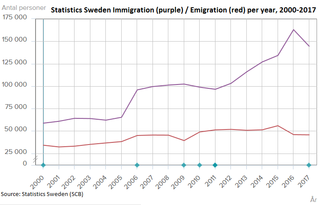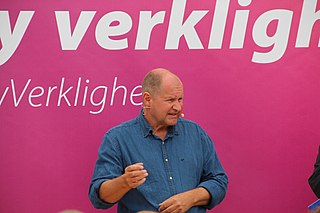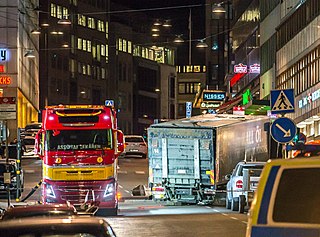
The Nordic Passport Union allows citizens of the Nordic countries – Iceland, Denmark, Norway, Sweden, and Finland – to travel and reside in another Nordic country without any travel documentation or a residence permit. Since 25 March 2001, all five states are also in the Schengen Area.

The National Task Force, formerly known as the National Task Force of the Swedish Civilian Police, is a police tactical unit within the National Operations Department of the Swedish Police Authority.

Crime in Sweden is defined by the Swedish Penal Code and in other Swedish laws and statutory instruments.
Kurt Niklas Lindgren, known in the media prior to his arrest as Hagamannen, is a convicted Swedish serial rapist. Lindgren was convicted of nine counts of sexual assault in 2006, two of which were labeled attempted murder, in relation to attacks in the city of Umeå from 1998 to 2005. The attacks were all made outdoors, involved physical violence and in some cases attempts to kill his victims. The nickname "Hagamannen" refers to the area in Umeå named Haga where Lindgren made his first assault.

Tynnered is one of 21 boroughs in the city of Gothenburg, Sweden. It is located in the western part of the city, about 8-10 kilometres from the inner city, and it has a population of 27,787 (2010) on 29.85 square kilometres (11.53 mi2). Alike several other boroughs of the city, Tynnered has a fairly high percentage of immigrants. On January 1, 2011, Tynnered became part of the district (stadsdelsnämnd) Western Gothenburg. In 2021 the stadsdelsnämd districts were replaced by larger stadsområde districts and Tynnered became part of South-West Gothenburg.
Law enforcement in Sweden is carried out by several government agencies, under the guidance of the Government of Sweden.
The Swedish National Police Board was the central administrative authority for the police in Sweden from 1 January 1965 to 1 January 2015, when the Swedish Police Authority was established. The Swedish police used to consist of the National Police Board and 21 local police authorities, with their geographical areas of responsibility divided along county lines. The board was led by the National Police Commissioner and its main responsibilities were administration, coordination and supervision of the Swedish police. It also acted as the superordinate authority for the National Laboratory of Forensic Science. The Swedish National Criminal Police — sometimes also referred to as the Swedish National Bureau of Investigation — used to be a constituent part of the National Police Board, together with the Swedish Security Service. The Swedish Security Service formed its own agency post-reorganization, and most of the tasks handled by the National Criminal Police have been taken over by the National Operations Department.
Magnus Ingesson, born February 18, 1971, in Luleå, Sweden, is a Swedish former cross-country skier who competed from 1993 to 2004. He earned a silver medal in the 4 × 10 km relay at the 2001 FIS Nordic World Ski Championships in Lahti, and had his best individual finish of ninth in the 15 km event at those same championships.

Swedish passports are issued to nationals of Sweden for the purpose of international travel. Besides serving as proof of Swedish citizenship, they facilitate the process of securing assistance from Swedish consular officials abroad.

The Swedish national identity card is a non-compulsory biometric identity document issued in Sweden. It is one of two official identity documents issued by the Swedish Police, the other being the Swedish passport. It is only issued to Swedish citizens, and indicates the citizenship.
Reinforced Regional Task Force, prior to 2015 officially known as Piketen is a regional special operations asset of the Swedish Police Authority, similar to SWAT type units in the United States. RRTF is called upon when situations occur that are too dangerous for ordinary police to handle such as hostage situations, serving high-risk arrest warrants and confronting armed criminals. RRTF units are based in Stockholm, Gothenburg and Malmö.
Black Cobra is one of the largest immigrant street gangs in Denmark and is represented in most major Danish cities, with approximately 100 members. The gang is also active in Sweden, having established itself in the Malmö district Rosengård and the Stockholm suburbs of Tensta, Rissne and Rinkeby. The Black Cobra gang also control a youth gang called the Black Scorpions. Their criminal activity involves drug trafficking, robbery, theft, racketeering, extortion and murder. The police describe Black Cobra as a loose network composed of strong leadership figures. Black Cobra members wear black and white shirts with an emblem on the back of a cobra in attack position. The shirts also have Black Cobra written on them, above the emblem in Old English-style writing.

Immigration to Sweden is the process by which people migrate to Sweden to reside in the country. Many, but not all, become Swedish citizens. The economic, social, and political aspects of immigration have caused some controversy regarding ethnicity, economic benefits, jobs for non-immigrants, settlement patterns, impact on upward social mobility, violence, and voting behaviour.

Gottsunda, is a district in Uppsala, Sweden. In 2007, it had 9,474 inhabitants. The majority of the buildings are high-rise buildings built as part of the Million Programme in the 1960s and 1970s.

An officer is a person who holds a position of authority as a member of an armed force or uniformed service.

The Swedish Police Authority is the national police force (Polisen) of the Kingdom of Sweden. The first modern police force in Sweden was established in the mid-19th century, and the police remained in effect under local government control up until 1965, when it was nationalized and became increasingly centralized, to finally organize under one authority January 1, 2015. Concurrent with this change, the Swedish Security Service formed its own agency. The new authority was created to address shortcomings in the division of duties and responsibilities, and to make it easier for the Government to demand greater accountability. The agency is organized into seven police regions and eight national departments. It is one of the largest government agencies in Sweden, with more than 28,500 employees, of which police officers accounted for approximately 75 percent of the personnel in 2014. It takes two and a half years to become a police officer in Sweden, including six months of paid workplace practice. Approximately a third of all police students are women, and in 2011 women accounted for 40 percent of all employees.

Dan Tore Eliasson is a Swedish lawyer and civil servant. He served as Director–General of the Swedish Migration Agency from 2007 to 2011, as Director–General of the Swedish Social Insurance Agency from 2011 to 2014, as National Police Commissioner from 2014 to 2018 and as Director–General of the Swedish Civil Contingencies Agency (MSB) from 2018 until his dismissal in 2021. After his dismissal in 2021, he was placed as Director-General of the Division of Crisis Preparedness of the Ministry of Justice until the end of 2022.

On 7 April 2017, a vehicle-ramming Islamist terrorist attack took place in central Stockholm, the capital of Sweden. A hijacked truck was deliberately driven into crowds along Drottninggatan before being crashed into an Åhléns department store. Five people, the youngest an 11 year old girl, were killed. 14 others were seriously injured.
Vulnerable area is a term applied by the Swedish Police Authority to areas with high crime rates and social exclusion. In the December 2015 report, there were 53 vulnerable areas, which increased to 61 in June 2017. The increase is reported to be due to better reporting, not a changing situation. The overall trend is that these areas are improving.









































